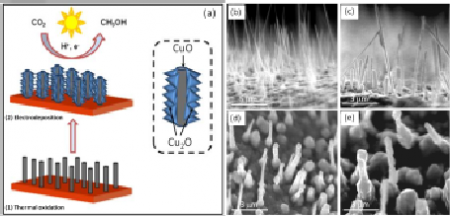Feb
22
Carbon Dioxide Plus Sunlight with Copper Gets Methanol
February 22, 2013 | 6 Comments
Researchers from The University of Texas at Arlington (UTA) are pioneering a new method for using carbon dioxide, or CO2, to make liquid methanol fuel by using copper oxide nanowires and sunlight. In a brainstorm sure to warm the hearts of coal and natural gas burners the possibility could come for CO2 to go right back for a second fuel or chemical product with the carbon emitted drastically reduced. Methanol used to run a fuel cell would keep the CO2 in a closed cycle.
Krishnan Rajeshwar, interim associate vice president for research at UTA reports through the press release the process is safer, simpler and less expensive than previous methods to convert the greenhouse gas associated with climate change to a useful product. The research has been published in the journal Chemical Communications.
The UTA researchers began with copper oxide, CuO, nanorods and then coating the walls of with crystallites made from another form of copper oxide, Cu2O. In the lab, they submerged those rods in a water-based solution rich in CO2. Irradiating the combination with simulated sunlight created a photoelectrochemical reduction of the CO2 and that produced the methanol.

Carbon Dioxide to Methanol Illustration. A schematic illustration of the two-step synthesis of CuO-Cu2O hybrid nanorod arrays. Click image for the largest view.
This elegant and simple process compares to current methods requiring the use of a co-catalyst and must be conducted at high operating pressures and temperatures. Many also use toxic elements, such as cadmium, or rare elements, such as tellurium, explained Rajeshwar.
Rajeshwar is a distinguished professor of chemistry and biochemistry and co-founder of the Center for Renewable Energy, Science & Technology, CREST, at UTA. In an overlook he said, “As long as we are using fossil fuels, we’ll have the question of what to do with the carbon dioxide. An attractive option would be to convert greenhouse gases to liquid fuel. That’s the value-added option.”
In addition to the Chemical Communications journal, the new work also was featured in a recent edition of Chemical and Engineering News. That piece noted that the experiments generated methanol with 95 percent electrochemical efficiency and avoided the excess energy input, also known as overpotential, of other methods.
The work looks to be very significant. Its well worth noting and acknowledging the co-authors of the Chemical Communications published paper, “Efficient solar photoelectrosynthesis of methanol from carbon dioxide using hybrid CuO-Cu2O semiconductor nanorod arrays,” are Ghazaleh Ghadimkhani, Norma Tacconi, Wilaiwan Chanmanee and Csaba Janaky, all of the UT Arlington College of Science’s Department of Chemistry and Biochemistry and CREST. Janaky also has a permanent appointment at the University of Szeged in Hungary.
Rajeshwar said he hopes that others will build on the research involving copper oxide nanotubes, CO2 and sunlight.
Carolyn Cason, vice president for research at UTA said, “Addressing tomorrow’s energy needs and finding ways to stem the harmful effect of greenhouse gases are areas where UTA scientists can connect their work to real-world problems. We hope solutions in the lab are only the beginning.”
Norma Tacconi, a recently retired research associate professor at UTA, said the two types of copper oxide were selected because both are photoactive and they have complementary solar light absorption. “And what could be better in Texas than to use the sunlight for methanol generation from carbon dioxide?”
The context of the press release suggests that Rajeshwar may not be following through, leaving progress for others. Tacconi has retired. It’s not an exciting situation – rather the situation is looking for new leadership.
Other than fuel, methanol is used in a wide variety of chemical processes, including the manufacturing of plastics, adhesives and solvents as well as wastewater treatment. In the United States, there are 18 methanol production plants with a cumulative annual capacity of more than 2.6 billion gallons. Methanol is widely used, and more can only help.
As a fuel methanol can be added to most liquid petroleum fuels as an extender, octane booster, cleaner, and pollution reducer. It’s also a very handy way to load a fuel cell. An abundance of liquid, non-pressurized methane can be handled by the public with great confidence – just what a fuel cell market needs.
Comments
6 Comments so far


Thanks for the writeup. This is what I have been searching for.
I am glad to come across this page because I am currently doing a school project on this topic.
Wow this is a nice website. Very detailed and informative. Bookmarked this site.
I have been searching for this topic and i am glad to come across this page. Bookmarked!
Superbly written article, i have bookmarked your page. This is what i am looking for. Thanks for the awesome writeup
This is a very well written article. Thanks you for posting it. I have been looking around on related topic for a long time